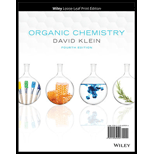
ORGANIC CHEMISTRY-PRINT (LL)-W/WILEY
4th Edition
ISBN: 9781119761105
Author: Klein
Publisher: WILEY
expand_more
expand_more
format_list_bulleted
Question
error_outline
This textbook solution is under construction.
Students have asked these similar questions
Ideal Gas Law Practice
Name
If you need a refresher on Ideal Gas Law, go back to your Ideal Gas Law Reading Assignment from last
week!
On all of the following, you'll need to make sure to convert pressures to atm and convert temperatures to
Kelvin in order to be able to use the R gas constant on your equation sheet!
Given: Ideal Gas Law =
then P= pressure
V = volume
R= ideal gas consent
PV=nRT
namount of substance
n=PV/TR
P=nRT/V
I = temperature
V=nRT/P
T=PV/nR
R=PV/nT
1. What pressure is required to contain 0.023 moles of nitrogen gas in a 4.2 L container at a
temperature of 20.°C?
2. Oxygen gas is collected at a pressure of 123 kPa in a container which has a volume of 10.0 L. What
temperature must be maintained on 0.500 moles of this gas in order to maintain this pressure? Express
the temperature in degrees Celsius.
3. How many moles of chlorine gas would occupy a volume of 35.5 L at a pressure of 100.0 kPa and a
temperature of 100. °C? After determining the number of moles,…
1. The following conversion includes chemistry we have covered very recently, some
chemistry from last term, and chemistry from the first chapter of this unit. Provide curly
arrows and an explanation for this mechanism. Use the reagents in the order given. You
do not need any other reagents.
1. NaOEt
OEt
2.
COOEt
COOEt
Step 1
Step 2
Step 3
COOEt
COOEt
COOH
Step 6
OH
Step 4
Step 7
(racemic)
cyclizes under
conditions (8)
OTS
Step 5
Step 8
ОН
OH
(racemic)
Frontalin
(racemic)
Shown above are the steps in one of the several published syntheses of Frontalin, a pheromone of the western pine beetle. From the choices provided, show
the reagents and conditions by which step 3 of this synthesis might be accomplished.
List the reagent(s) in order that will accomplish this transformation. No more than 4 steps are required. List your answer as a single letter (single-step
transformation) or a series of letters (multi-step transformation) with no commas separating them.
For example, "ab" corresponds to:
1. Eto Na+
2. NaOH, H₂O
NOTE: The order in which you list your letters matters!
Reagents:
a. Eto Na*
g. NaCN
b. NaOH, H₂O
h. SOCI₂
c. H3O+, heat
i. (CH3)2CuLi, ether, -78°C
d. LiAlH4
j. H₂O
e. p-TsCI, pyridine
k. RCO3H
f.
Br
I. H3O+
1,024
Knowledge Booster
Similar questions
- K ← nationa Login - Paymentivet MapQue Draw the major product of this reaction. Ignore inorganic byproducts and the carboxylic acid side product. N 1. excess LiAlH4 2. H₂O ✓ W aarrow_forwardDraw the major product of this reaction. Ignore inorganic byproducts and the alcohol side product. 1. H3O+, heat 2. Neutralizing work-up Drawing Qarrow_forwardIndicate the procedure (reagent Z) to go from compound A1 to compound A2. A1 Z P(C6H5)3 A2arrow_forward
- Please help with this graph.arrow_forwardogin - PaymentN MapQuest 3 Overview - SAP NetW... Draw the major product of this reaction. Ignore inorganic byproducts. CI 1. NaBH4 2. H₂O C Clever | Portal Job Op Problem Atoms, Bonds and Rings Draw or tap a new bond toarrow_forward2. Draw the remaining two resonance structures for the carbocation intermediate in the meta nitration of methyl benzoate AND explain why the meta orientation is preferred. Hint: how is the placement of the cation favorable after addition of nitronium relative to the electron withdrawing group? (2 pts) H NO2 CO₂Mearrow_forward
- Label all absorptions over 1500 cm-1. Please be specific and mark IR if needed for explanation. Compound OH sp^3 C-H C=O C-O Triglyceridearrow_forwardIdentify the intermediate that is INITIALLY formed in a saponification reaction (hydrolysis of an ester). III -OH H₂O HO OH HO O || A B C III D IV IVarrow_forwardHelp me answer this practice sheet I found for an answer guidearrow_forward
- show the retrosynthesis of this molecule step by step starting with 1,3-dimethoxy benzene H3CO OH OH OCH 3arrow_forwardConsider the reaction of a propanoate ester with hydroxide ion shown below. A series of four alcohol leaving groups were tested to determine which would be the best leaving group. Based on the pKa values of the alcohols, predict which alcohol would produce the fastest hydrolysis reaction. HO FOR A Alcohol I, pKa =16.0 B Alcohol II, pKa =10.0 C Alcohol III, pKa = 7.2 + ROH D Alcohol IV, pKa = 6.6arrow_forwardCurved arrows are used to illustrate the flow of electrons. Using the provided starting and product structures, draw the curved electron-pushing arrows for the following reaction or mechanistic step(s). Be sure to account for all bond-breaking and bond-making steps. :0: NaOH, H₂O 00:4 Na O heat NaO Select to Add Arrows Select to Add Arrows :0: Na a NaOH, H2O :0: NaOH, H2O heat heat Na ONH Select to Add Arrowsarrow_forward
arrow_back_ios
SEE MORE QUESTIONS
arrow_forward_ios
Recommended textbooks for you

 Organic ChemistryChemistryISBN:9781305580350Author:William H. Brown, Brent L. Iverson, Eric Anslyn, Christopher S. FootePublisher:Cengage Learning
Organic ChemistryChemistryISBN:9781305580350Author:William H. Brown, Brent L. Iverson, Eric Anslyn, Christopher S. FootePublisher:Cengage Learning


Organic Chemistry
Chemistry
ISBN:9781305580350
Author:William H. Brown, Brent L. Iverson, Eric Anslyn, Christopher S. Foote
Publisher:Cengage Learning